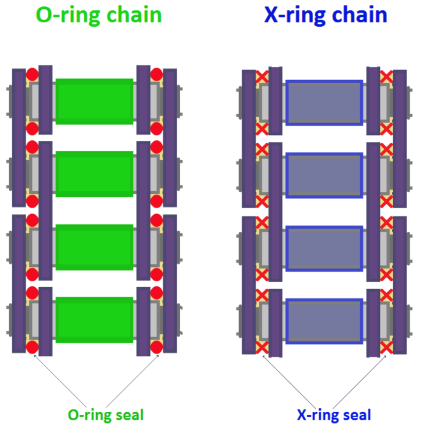
O-ring chain. Non O-ring chain. Now, X-ring chain?
An x-ring dirt bike chain is newer, far newer actually, than the standard non O-ring chain that probably propelled the first bicycle. The O-ring chain debuted in 1971 while the X-ring has been around for about 10 years or so and has become a popular choice for off-road riders. The X-ring chain may sound like the latest superhero but in fact is a type of O-ring chain.
You can read more about the difference between O-ring chains and non O-ring chains by reading "O-ring Chain vs Non O-ring" but briefly the O-ring chain has a more robust profile and weighs more. The O-rings are actually self-lubricating rubber inserts that fit in between the outside link plates and inside the roller link plates, seal in lubrication and seal out dirt and debris around the pin and in between the plates.
An X-ring chain offers a similar profile but the difference between the O-ring and X-ring chain refers to the type or maybe style of seals in each link. In both types of chains, the X-ring or O-ring seal fits in between the inner and outer plates used to grease the pins and bushing and keep dirt out. An O-ring seal looks circular, like an "O" while the X-ring chain uses a seal that resembles an "X." See diagram:

Compared to standard chains, O-ring chains cost more but last much longer with far more durability as the self-lubricating properties prevent premature wear when busting through sand tracks or riding caked in mud. You don't have to regularly lubricate O-ring chains as a standard chain though most riders generally add a spray of chain wax before riding anyway. All of the benefits to an O-ring chain apply to an X-ring chain.
O-Ring vs. X-Ring
So, what's the difference between an O-ring chain and an X-ring chain?
The X-ring has several advantages over the O-ring chain including:
- A standard O-ring, when squeezed between the inner and outer plates, deforms and has a large surface area.
- An X-ring seal placed between the inner and outer plates twists as opposed to being squashed. This creates two smaller sealing surfaces with less friction and wear.
- An X-ring also distorts less than a standard O-ring, and the gap between the sealing surfaces does a better job of retaining grease.
Additionally, D.I.D. a well-respected manufacturer of dirt bike chains, that makes standard dirt bike chains, O-ring dirt bike chains and X-ring dirt bike chains indicates their X-ring chains last twice as long as their O-ring chains - roughly 20,000 miles vs. 10,000 miles.
The disadvantages of using X-ring chain in place of an O-ring chain include:
- Cost (though not always)
- Improper fit
X-ring and O-ring chains are wider than standard non O-ring chains but an X-ring chain installed on a dirt bike using non O-ring chain as OEM might not have proper clearance of the engine case near the countershaft sprocket and other places of close contact. You can damage the chain and motorcycle if you ride without the acceptable clearance. However, newer 250cc and larger dirt bikes do not have this issue. Some older and smaller bore bikes can have clearance issues, therefore, always test fit and spin the rear wheel before riding.
Whether you choose an O-ring chain or X-ring chain both require regular cleaning and though the seals keep the inner components of the chain lubricated and safe from dirt, the external rollers, plates and the rings require frequent lubrication.








